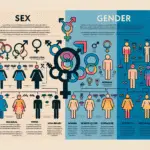Understanding how people connect, love, and form relationships
Human beings are beautifully diverse—and so are the ways we experience love, attraction, and relationships. Sexual orientation is one important aspect of that diversity. It’s about who we’re emotionally, romantically, and/or physically attracted to.
While many of us are familiar with terms like “straight” or “gay,” the reality is much more complex and flexible. In this article, we’ll explore what sexual orientation means, how it exists on a spectrum, and why understanding it helps build a more respectful, inclusive world.
What Is Sexual Orientation?
Sexual orientation refers to a person’s emotional, romantic, or physical attraction to other people. It’s part of who we are—it can influence how we connect with others, build relationships, and form a sense of identity.
It’s important to note:
-
Sexual orientation is not the same as gender identity.
-
It is not a choice—it’s a natural part of being human.
-
It may be stable for some people, and fluid or changing for others over time.
The Spectrum of Orientation
Sexual orientation isn’t a simple yes/no or either/or category. It exists on a spectrum, which means people can experience attraction in different ways and to different degrees. Here are some common orientations, though not an exhaustive list:
1. Heterosexual (Straight)
-
Attracted to people of the opposite gender.
-
Example: A woman attracted to men or a man attracted to women.
2. Homosexual (Gay/Lesbian)
-
Attracted to people of the same gender.
-
“Gay” is often used for men; “lesbian” is commonly used for women.
3. Bisexual
-
Attracted to more than one gender.
-
May experience attraction differently toward different genders.
4. Pansexual
-
Attracted to people regardless of gender.
-
Focuses more on the person than their gender identity.
5. Asexual
-
Experiences little or no sexual attraction.
-
May still form deep emotional or romantic relationships.
6. Queer
-
A broad, inclusive term used by some people who don’t identify with traditional labels or who want to reject strict categories.
-
It can mean different things to different individuals.
7. Questioning
-
Some people are still exploring their orientation and may not be sure how they identify yet—and that’s okay.
Orientation Is Personal and Valid
Each person’s orientation is deeply personal. Some people know how they identify from a young age. Others may discover it over time. What’s important is that all orientations are valid, and no one should feel pressured to label themselves before they’re ready.
Also, remember:
-
Some people may not talk openly about their orientation for cultural, religious, or personal reasons.
-
Being respectful means listening, accepting, and never making assumptions.
Why Understanding the Spectrum Matters
Knowing that sexual orientation exists on a spectrum helps:
-
Promote empathy and respect for people with different experiences
-
Support inclusivity in schools, workplaces, and communities
-
Challenge stereotypes and harmful assumptions
-
Help individuals feel seen and accepted for who they are
When people feel understood, they’re more likely to live confident, authentic lives—free from shame or fear.
Final Thoughts
Human connection is at the heart of life, and sexual orientation is one way we understand how people connect. By exploring the spectrum with an open mind and heart, we create a world that celebrates diversity instead of dividing it.
Whether you’re learning for yourself, a friend, or your community—thank you for being curious, respectful, and compassionate.
